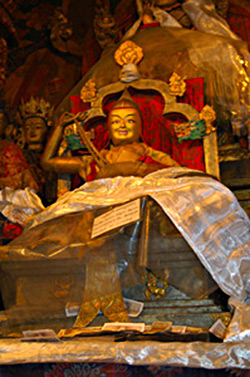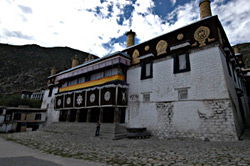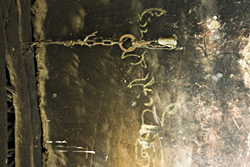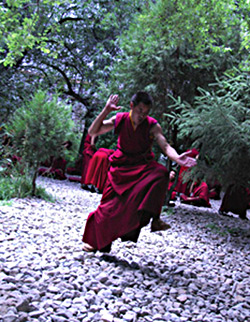by Georges Dreyfus and THL.
The Loselling Monastic College (Loselling Dratsangblo gsal gling grwa tshang)
LosellingBlo gsal gling was founded by LekdenLegs ldan, one of the disciples of Jamyang Chöjé’Jam dbyangs chos rje, the founder of Drepung’Bras spungs. Not much is known about the beginnings of this institution, which seems at first to have been rather modest, Gomang being the first and more important scholastic college at Drepung’Bras spungs. The rise of LosellingBlo gsal gling to being a prominent college may have started with Jamyang Lekpa Chönjor’Jam dbyangs legs pa chos ’byor (1429-1504 CE), also known as Jamyang Gawé Lodrö’Jam dbyangs dga’ ba’i blo gros, who became a very popular teacher at Drepung’Bras spungs. He studied with Gungru Chökyi LodröGung ru chos kyi blo gros and Baso ChöjéBa so chos rje, KhedrupMkhas grub’s own cousin and an important figure in his own right in the formation of the GelukDge lugs tradition. After a prolonged training at the Lower College of Sangphu, where he became known for his scholarship, Jamyang Lekpa Chönjor’Jam dbyangs legs pa chos ’byor went to KhamKhams. He quickly came back to Central Tibet, however, and taught for more than twenty years at LosellingBlo gsal gling, gathering an impressive number of students among whom figures prominently Gendün GyatsoDge ’dun rgya mtsho (1475-1542 CE), the retrospective Second Dalai Lama (Talé Lama Kutreng NyipaTā la’i bla ma sku phreng gnyis pa). Jamyang Lekpa Chönjor’Jam dbyangs legs pa chos ’byor was appointed as the Eighth Throne-Holder of Drepung (Drepung Tripa Gyepa’bras spungs khri pa brgyad pa). During his tenure, he continued his teaching activities at LosellingBlo gsal gling and with the support of the NedongNe’u dong family built monumentThe great statue of Maitreya. His writings were the first scholastic manuals of the the Loselling Monastic College (Loselling Dratsangblo gsal gling grwa tshang).

Penchen Sönam DrakpaPaṇ chen bsod nams grags pa as a Student in the LosellingBlo gsal gling Assembly Hall
LosellingBlo gsal gling’s rise continued with Penchen Sönam DrakpaPaṇ chen bsod nams grags pa (1478-1554 CE), one of the leading GelukDge lugs teachers of the sixteenth century. Born in a troubled time, Sönam DrakpaBsod nams grags pa belonged to a generation of GelukDge lugs thinkers who saw their main task as defending and expending TsongkhapaTsong kha pa’s (1357-1419 CE) tradition in the face of the opposition from KagyüBka’ brgyud and SakyaSa skya schools. This opposition took the form of virulent polemics against TsongkhapaTsong kha pa as well as political and military attacks against GelukDge lugs monasteries, all this taking place within the context of an on-going civil war between Central Tibet and TsangGtsang. Jetsün Chökyi GyeltsenRje btsun chos kyi rgyal mtshan (1469-1544 CE), the author of the scholastic manuals of Sera JéSe ra byes, is typical of this difficult period during which the GelukDge lugs tradition was under duress. He wrote refutations of some of the most virulent polemics against TsongkhapaTsong kha pa, particularly those written by the Eighth Karmapa (Karmapa GyepaKarma pa brgyad pa) Mikyö DorjéMi bskyod rdo rje (1507-1554 CE), GorampaGo ram pa (1429-1489 CE), and Shakya ChokdenShākya mchog ldan (1428-1509 CE).
Penchen Sönam DrakpaPaṇ chen bsod nams grags pa was less involved in polemical tasks. Perhaps, he considered that Chökyi GyeltsenChos kyi rgyal mtshan had already done this successfully and there was no need for further polemics. Or, he may have preferred a less confrontational approach. In any case, he devoted his life to writing numerous texts articulating the GelukDge lugs standpoint. His literary production was impressive, ranging from the scholastic manuals adopted by LosellingBlo gsal gling to the study of tantras, the history of the GelukDge lugs tradition, and the history of the Discipline (Dülwa’dul ba, Vinaya). His writings were the expressions of a vast learning acquired by a keen mind well educated in the ways typical of the scholars of the time. He studied for many years at SeraSe ra, particularly with Jamyang Dönyö Penden’Jam dbyangs don yod dpal ldan and Penjor LhündrupDpal ’byor lhun grub (1427-1514 CE). He then went on a scholastic tour of some of the main centers and successfully defended his views at TsetangTshe thang where he was given the title of Great Scholar (Rapjamrab ’byams). After that, he entered the Tantric Monastery of Upper Lhasa (Gyütörgyud stod) where he studied extensively the Indian tantras, TsongkhapaTsong kha pa’s tantric works and the GelukDge lugs ritual lore. At the age of thirty-four (that would be 1511 by Tibetan reckoning), he was appointed as abbot of the Tantric Monastic College (Ngakpa Dratsangsngags pa grwa tshang). A year later he was asked by Gendün GyatsoDge ’dun rgya mtsho, by then Drepung’Bras spungs’s uncontested leader, to teach at the Loselling Monastic College where he spent many years gathering a very large number of students around him. Together with Lekpa ChönjorLegs pa chos ’byor, he is said to have been the most successful teacher at Drepung’Bras spungs.

LosellingBlo gsal gling Courtyard and Assembly Hall
In 1529, Penchen Sönam DrakpaPaṇ chen bsod nams grags pa was appointed to dga’ ldan khri, a position he occupied for several years. In 1535, he seems to have retired from his official position and spent his time teaching and writing in his residency at Drepung’Bras spungs. He was brought out of retirement by Gendün GyatsoDge ’dun rgya mtsho’s death, which prompted the NedongNe’u dong family and the Drepung authorities (Drepung chiso’bras spung spyi gso) to ask him to assume the leadership of the monastery. In this position, he restored the discipline of the monastery, which seems to have declined, perhaps due to the difficult times that the monastery had gone through in the early decades of the sixteenth century. He was very active as an abbot, repairing a number of buildings that had fallen apart in the earlier decades. He also assumed the Sera Throne (Sera Trise ra khri) and acted as abbot for the ordination of Sönam GyatsoBsod nams rgya mtsho (1543-1588 CE), the Third Dalai Lama (Talé Lama Kutreng SumpaTā la’i bla ma sku phreng gsum pa). When he died in 1554 at the age of seventy-six, he was greatly respected, being considered the foremost GelukDge lugs teacher of his day. LosellingBlo gsal gling, where he had taught for many years, adopted his scholastic texts as their official manuals in replacement of Jamyang Lekpa Chönjor’Jam dbyangs legs pa chos ’byor’s earlier writings. Later on, repeated attempts to promote new texts as the official LosellingBlo gsal gling manuals failed in the face of the attachment of LosellingBlo gsal gling monks to Sönam DrakpaBsod nams grags pa’s texts, despite the fact that these texts are not as complete as Jamyang Zhepa’Jam dbyangs bzhad pa’s works, the manuals of Gomang, LosellingBlo gsal gling’s great rival at Drepung’Bras spungs. But Sönam DrakpaBsod nams grags pa’s influence has not been limited to Drepung’Bras spungs. Many of his writings, particularly his History of the Vinaya (Dülwa Chönjung’Dul ba chos ’byung) and his General Presentation of the Tantras (Gyüdé ChinamRgyud sde spyi rnam) have been widely read in GelukDge lugs circles, and he continues to be one of the tradition’s major later thinkers.
It is likely that the preeminence of LosellingBlo gsal gling at Drepung’Bras spungs dates back to the illustrious careers of these two great teachers, Jamyang Lekpa Chönjor’Jam dbyangs legs pa chos ’byor and Penchen Sönam DrakpaPaṇ chen bsod nams grags pa. Afterwards, LosellingBlo gsal gling continued to grow, becoming by far the largest college in the three GelukDge lugs monastic seats. In the twentieth century, its monks may have numbered as many as six thousand and the number of its scholars was unmatched by any other college. LosellingBlo gsal gling was considered as the powerhouse of GelukDge lugs scholasticism, producing a number of holders of dga’ ldan khri, the position officially held by TsongkhapaTsong kha pa’s successor since the Fifth Throne-Holder of Drepung (Drepung Tripa Ngapa’bras spungs khri pa lnga pa). Among the GelukDge lugs three seats of learning, only the Jé Monastic College (Dratsang Jégrwa tshang byes) of SeraSe ra could pretend rival with the scholarly achievements of this college.

LosellingBlo gsal gling Horse Stable
The curriculum at LosellingBlo gsal gling was rather typical of the GelukDge lugs seats of learning. Students started with the preliminary study of logic and epistemology and moved on the study of the five great treatises that constitute the core of the curriculum:
- Abhisamayālaṃkāra attributed to JampaByams pa
- Dharmakīrti’s Pramāṇavārttika
- Candrakīrti’s Madhyamakāvatāra
- Vasubandhu’s Abhidharmakośa
- Guṇaprabha’s Vinayasūtra
These five treatises were studied one after the other through a program of fifteen classes, starting with the Collected Topics (Düdrabsdus grwa) and ending with the study of the abhidharma. The abbot of the monastery oversaw this curriculum, making sure that the institution was running properly and the general schedule was kept. But the day to day running of the scholastic studies were in the hands of the college’s disciplinarian and the director of the studies (lama zhung lenpabla ma gzhung len pa). The former oversaw the overall discipline of the college and as such was in charge of the running of the debating courtyard. He would make sure that the proper rituals were held and that the debates were well organized, class by class. He would be seconded in this task by the leaders of each class (kyorpönskyor dpon) who were in charge of making sure that the right texts were memorized, the proper topics studied, and the debates well attended. These class-leaders would be overseen by a chief-class leader (karam kyorpönbka’ rams skyor dpon) in charge of overseeing the work of the leaders and of reporting to the disciplinarian. The studies director was in charge of overseeing some of the other aspects of the scholastic program such as ensuring that the proper exams were held, the candidates chosen according to their abilities, etc.

Monks debating at LosellingBlo gsal gling
In exile in India, LosellingBlo gsal gling has maintained its curriculum, structure and organization. The twenty-four regional houses still exist and have kept some of their original functions, but in a population of refugees that has been in exile for several decades and has acquired a relatively standardized Tibetan language and culture, regional affiliation do not have the same meaning as they had in the old society where culture and language were to a large extent regional. The administrative structure of the college has been maintained. The abbot of the monastic college is chosen by the Dalai Lama (Talé LamaTā la’i bla ma) and the other officials, the disciplinarian, the chant leader and the four steward monks in charge of running the monastery, are designated by a vote of the monks. The running of the monastic college, however, has been greatly simplified by the fact that it is much smaller (around two thousand at the turn of the twenty-first century) than it used to be and has much fewer resources.
In Tibet, LosellingBlo gsal gling has found it difficult to maintain its structure, curriculum and organization. The running of the whole of the monastic seat is in the hands of the DMC, which administers every details of the monastic life. In such a context, it makes little sense to speak of colleges or regional houses. Although monks continue to belong nominally to one of the four colleges, most of their activities, including rituals and scholastic studies, are held together within the context of the seat. Hence, there is little sense among the young monks of their belonging to a separate monastic college or a well-defined regional house, as it was the case prior to 1959. As for the curriculum, considerable efforts have been made to enable young monks to study as much as possible. But in a monastic population that is too small for the many tasks that have to be performed, it has been difficult to match the scholastic accomplishments of the past.
The Twenty-Four Regional Houses at LosellingBlo gsal gling
- TsaTsha
- KongpoKong po
- PukhangPhu khang
Three large regional houses
- RongpoRong po
- LhopaLho pa
- MinyakMi nyag
- PomborraSpom ’bor ra
- TrehorTre hor
- NyakréNyag re
Six middling regional houses
- GyaRgya
- TsülTshul
- TsangGtsang
- TsetangRtse thang
- PetupDpe thub
- GoGo
- ParaPha ra
- NyangpoNyang po
- LingGling
- DenmaLdan ma
- DrakpaGrags pa
- GugeGu ge
- GyelrongRgyal rong
- GyepaRgyas pa
- ÜtöDbus stod
Fifteen small regional houses
Drepung Monastery Home
Table of Contents
- The Gomang Monastic College
- The Loselling Monastic College
- The Deyang Monastic College
- The Tantric Monastic College
- Glossary
- Specify View:
- Specify Format:
 |  |  |